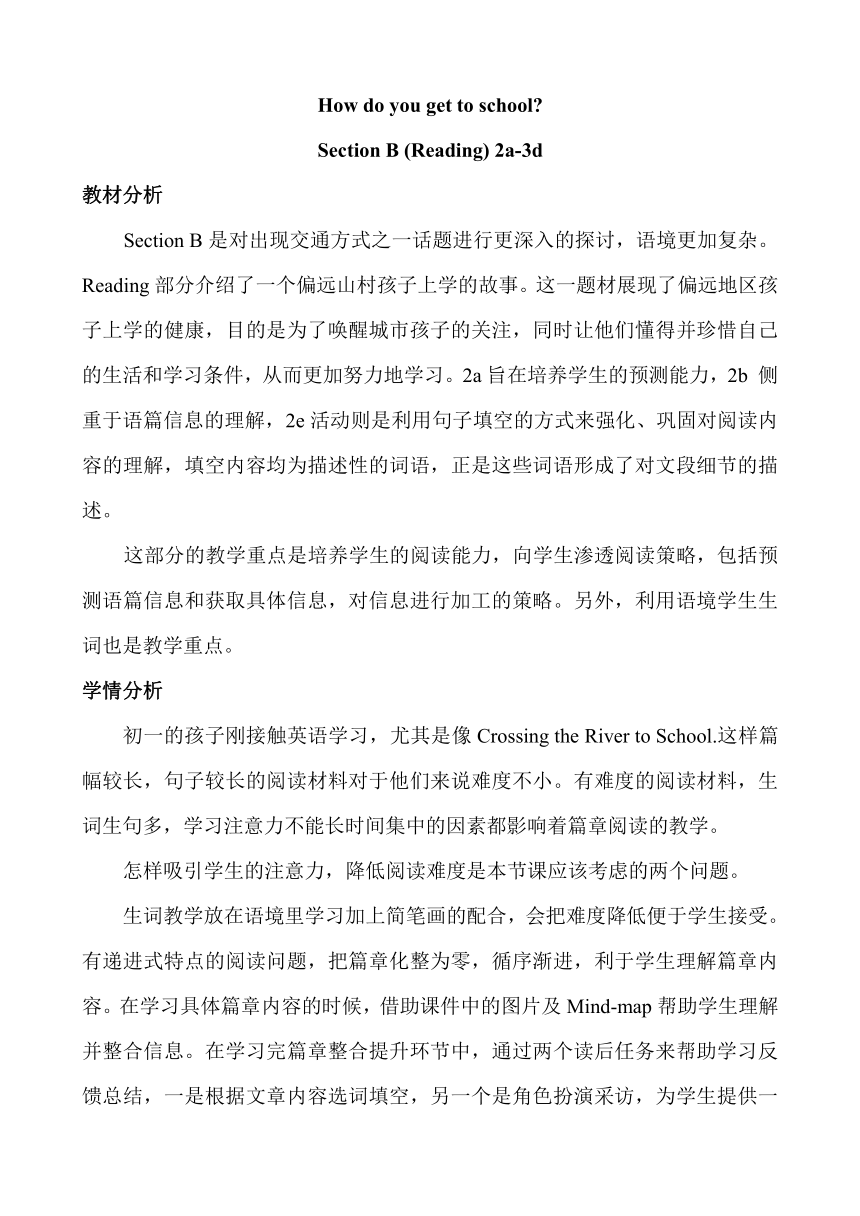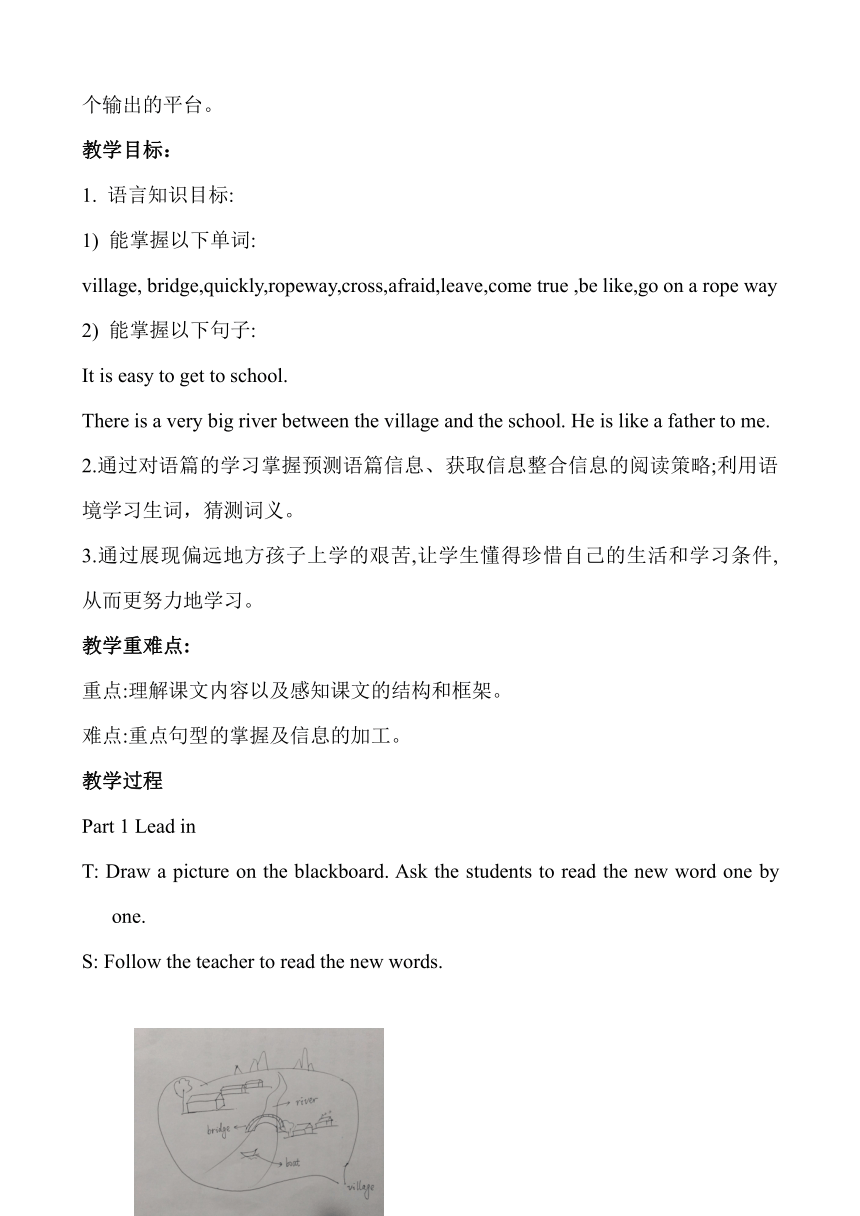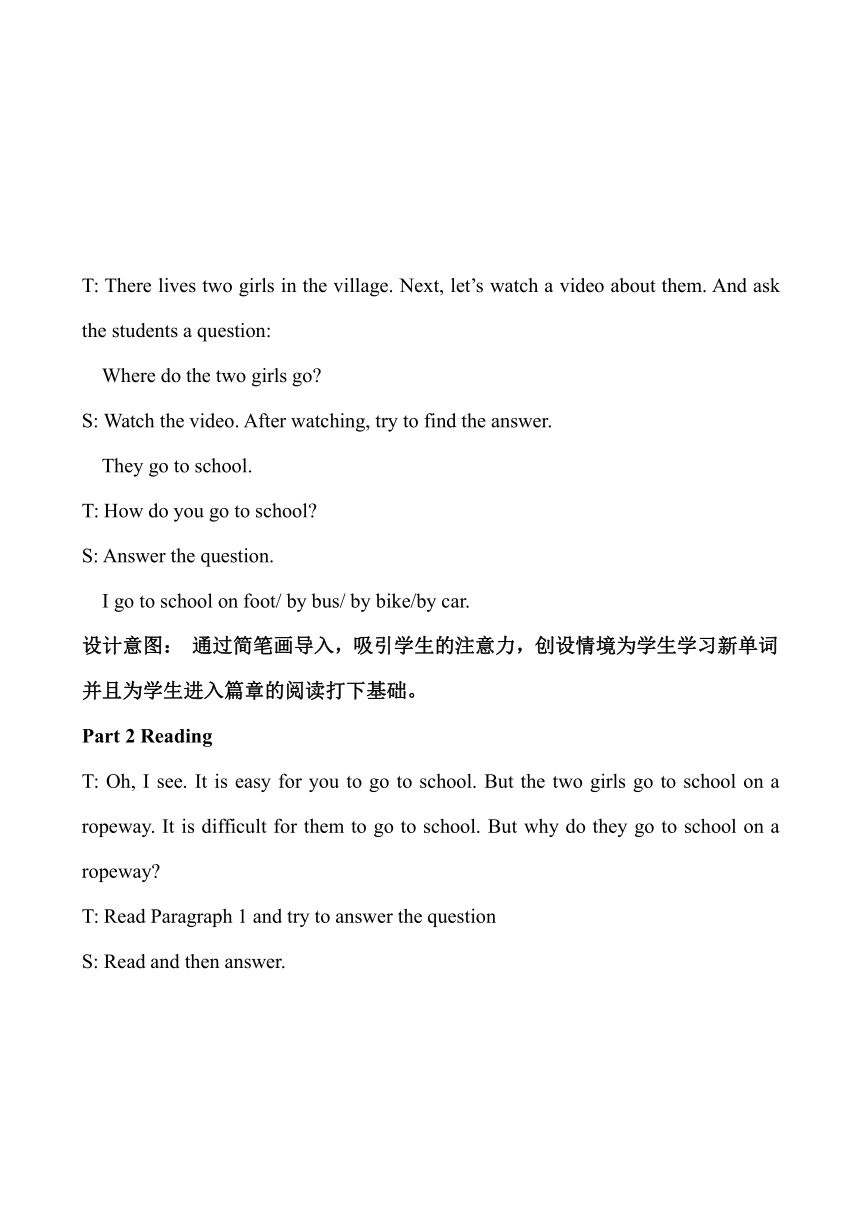鲁教六年级下学期Unit 5 How do you get to school? Section B 2a-3d教案
文档属性
| 名称 | 鲁教六年级下学期Unit 5 How do you get to school? Section B 2a-3d教案 |  | |
| 格式 | doc | ||
| 文件大小 | 16.5MB | ||
| 资源类型 | 教案 | ||
| 版本资源 | 鲁教版 | ||
| 科目 | 英语 | ||
| 更新时间 | 2022-04-11 16:55:59 | ||
图片预览



文档简介
How do you get to school
Section B (Reading) 2a-3d
教材分析
Section B是对出现交通方式之一话题进行更深入的探讨,语境更加复杂。Reading部分介绍了一个偏远山村孩子上学的故事。这一题材展现了偏远地区孩子上学的健康,目的是为了唤醒城市孩子的关注,同时让他们懂得并珍惜自己的生活和学习条件,从而更加努力地学习。2a旨在培养学生的预测能力,2b 侧重于语篇信息的理解,2e活动则是利用句子填空的方式来强化、巩固对阅读内容的理解,填空内容均为描述性的词语,正是这些词语形成了对文段细节的描述。
这部分的教学重点是培养学生的阅读能力,向学生渗透阅读策略,包括预测语篇信息和获取具体信息,对信息进行加工的策略。另外,利用语境学生生词也是教学重点。
学情分析
初一的孩子刚接触英语学习,尤其是像Crossing the River to School.这样篇幅较长,句子较长的阅读材料对于他们来说难度不小。有难度的阅读材料,生词生句多,学习注意力不能长时间集中的因素都影响着篇章阅读的教学。
怎样吸引学生的注意力,降低阅读难度是本节课应该考虑的两个问题。
生词教学放在语境里学习加上简笔画的配合,会把难度降低便于学生接受。有递进式特点的阅读问题,把篇章化整为零,循序渐进,利于学生理解篇章内容。在学习具体篇章内容的时候,借助课件中的图片及Mind-map帮助学生理解并整合信息。在学习完篇章整合提升环节中,通过两个读后任务来帮助学习反馈总结,一是根据文章内容选词填空,另一个是角色扮演采访,为学生提供一个输出的平台。
教学目标:
1. 语言知识目标:
1) 能掌握以下单词:
village, bridge,quickly,ropeway,cross,afraid,leave,come true ,be like,go on a rope way
2) 能掌握以下句子:
It is easy to get to school.
There is a very big river between the village and the school. He is like a father to me.
2.通过对语篇的学习掌握预测语篇信息、获取信息整合信息的阅读策略;利用语境学习生词,猜测词义。
3.通过展现偏远地方孩子上学的艰苦,让学生懂得珍惜自己的生活和学习条件, 从而更努力地学习。
教学重难点:
重点:理解课文内容以及感知课文的结构和框架。
难点:重点句型的掌握及信息的加工。
教学过程
Part 1 Lead in
T: Draw a picture on the blackboard. Ask the students to read the new word one by one.
S: Follow the teacher to read the new words.
T: There lives two girls in the village. Next, let’s watch a video about them. And ask the students a question:
Where do the two girls go
S: Watch the video. After watching, try to find the answer.
They go to school.
T: How do you go to school
S: Answer the question.
I go to school on foot/ by bus/ by bike/by car.
设计意图: 通过简笔画导入,吸引学生的注意力,创设情境为学生学习新单词并且为学生进入篇章的阅读打下基础。
Part 2 Reading
T: Oh, I see. It is easy for you to go to school. But the two girls go to school on a ropeway. It is difficult for them to go to school. But why do they go to school on a ropeway
T: Read Paragraph 1 and try to answer the question
S: Read and then answer.
S: According to the picture, the students try to retell paragraph 1.
设计意图:通过学生的上学方式和山区孩子的上学方式作为对比,让学生体验到自己的学习生活条件要好于山区孩子的条件。利用课间里图例及重点词汇的帮助,有助于学生对第一段的理解,2个原因促成山区孩子要坐索道上学,分别是有河没桥以及水流流速太快没法行船。并且为学生复述第一段主要内容降低了难度。
Part 3
T:Liang liang, a 11-year-old boy also lives in the village. Ask the students to read Para 2 and answer three questions.
Does he cross the river to school
Is he afraid
Does he like his school Why
S: Read Para 2 and answer the questions.
T: According to the picture, make an example to retell Para 2.
设计意图:利用简单的Mindmap为学生呈现第二段落中的重点内容,帮助学生理清思路,复述段落大意。
Part 4
T: The two girls go to school on a ropeway, and Liang liang crosses the river to school. It is difficult for them. And it is also dangerous. I think their parents are worried. So what do they want to have
S: Read Para 3 and try to answer the question.
T: It is their dream to have a bridge.
设计意图:阅读问题设置环环相扣,牢牢抓住篇章的重点词汇,引导学生阅读并理解篇章内容。
Part 5
T:Ask the students to read the text again, and according to the main idea, try to fill in the blanks.
S: Read and fill in the blanks. After that, lisen to the tape and try to follow the tape.
设计意图: 通过对内容的整合提取设计的选词填空的评价练习,检测学生对篇章内容的理解,提高学生对文本主要内容的整体把握,同时要求学生完成后跟读,练习口语朗读,将阅读和朗读这两种主要的英语学习方式有机结合起来。
Part 6
T: Ask the students to play in role. Make an interview between the reporter and Liang liang.
S: Work in pairs.
设计意图:通过角色扮演采访,创设情境让学生将阅读的内容内化变成自己的语言输出,达到阅读的最终目的,整合并输出。
Homework:
Section B (Reading) 2a-3d
教材分析
Section B是对出现交通方式之一话题进行更深入的探讨,语境更加复杂。Reading部分介绍了一个偏远山村孩子上学的故事。这一题材展现了偏远地区孩子上学的健康,目的是为了唤醒城市孩子的关注,同时让他们懂得并珍惜自己的生活和学习条件,从而更加努力地学习。2a旨在培养学生的预测能力,2b 侧重于语篇信息的理解,2e活动则是利用句子填空的方式来强化、巩固对阅读内容的理解,填空内容均为描述性的词语,正是这些词语形成了对文段细节的描述。
这部分的教学重点是培养学生的阅读能力,向学生渗透阅读策略,包括预测语篇信息和获取具体信息,对信息进行加工的策略。另外,利用语境学生生词也是教学重点。
学情分析
初一的孩子刚接触英语学习,尤其是像Crossing the River to School.这样篇幅较长,句子较长的阅读材料对于他们来说难度不小。有难度的阅读材料,生词生句多,学习注意力不能长时间集中的因素都影响着篇章阅读的教学。
怎样吸引学生的注意力,降低阅读难度是本节课应该考虑的两个问题。
生词教学放在语境里学习加上简笔画的配合,会把难度降低便于学生接受。有递进式特点的阅读问题,把篇章化整为零,循序渐进,利于学生理解篇章内容。在学习具体篇章内容的时候,借助课件中的图片及Mind-map帮助学生理解并整合信息。在学习完篇章整合提升环节中,通过两个读后任务来帮助学习反馈总结,一是根据文章内容选词填空,另一个是角色扮演采访,为学生提供一个输出的平台。
教学目标:
1. 语言知识目标:
1) 能掌握以下单词:
village, bridge,quickly,ropeway,cross,afraid,leave,come true ,be like,go on a rope way
2) 能掌握以下句子:
It is easy to get to school.
There is a very big river between the village and the school. He is like a father to me.
2.通过对语篇的学习掌握预测语篇信息、获取信息整合信息的阅读策略;利用语境学习生词,猜测词义。
3.通过展现偏远地方孩子上学的艰苦,让学生懂得珍惜自己的生活和学习条件, 从而更努力地学习。
教学重难点:
重点:理解课文内容以及感知课文的结构和框架。
难点:重点句型的掌握及信息的加工。
教学过程
Part 1 Lead in
T: Draw a picture on the blackboard. Ask the students to read the new word one by one.
S: Follow the teacher to read the new words.
T: There lives two girls in the village. Next, let’s watch a video about them. And ask the students a question:
Where do the two girls go
S: Watch the video. After watching, try to find the answer.
They go to school.
T: How do you go to school
S: Answer the question.
I go to school on foot/ by bus/ by bike/by car.
设计意图: 通过简笔画导入,吸引学生的注意力,创设情境为学生学习新单词并且为学生进入篇章的阅读打下基础。
Part 2 Reading
T: Oh, I see. It is easy for you to go to school. But the two girls go to school on a ropeway. It is difficult for them to go to school. But why do they go to school on a ropeway
T: Read Paragraph 1 and try to answer the question
S: Read and then answer.
S: According to the picture, the students try to retell paragraph 1.
设计意图:通过学生的上学方式和山区孩子的上学方式作为对比,让学生体验到自己的学习生活条件要好于山区孩子的条件。利用课间里图例及重点词汇的帮助,有助于学生对第一段的理解,2个原因促成山区孩子要坐索道上学,分别是有河没桥以及水流流速太快没法行船。并且为学生复述第一段主要内容降低了难度。
Part 3
T:Liang liang, a 11-year-old boy also lives in the village. Ask the students to read Para 2 and answer three questions.
Does he cross the river to school
Is he afraid
Does he like his school Why
S: Read Para 2 and answer the questions.
T: According to the picture, make an example to retell Para 2.
设计意图:利用简单的Mindmap为学生呈现第二段落中的重点内容,帮助学生理清思路,复述段落大意。
Part 4
T: The two girls go to school on a ropeway, and Liang liang crosses the river to school. It is difficult for them. And it is also dangerous. I think their parents are worried. So what do they want to have
S: Read Para 3 and try to answer the question.
T: It is their dream to have a bridge.
设计意图:阅读问题设置环环相扣,牢牢抓住篇章的重点词汇,引导学生阅读并理解篇章内容。
Part 5
T:Ask the students to read the text again, and according to the main idea, try to fill in the blanks.
S: Read and fill in the blanks. After that, lisen to the tape and try to follow the tape.
设计意图: 通过对内容的整合提取设计的选词填空的评价练习,检测学生对篇章内容的理解,提高学生对文本主要内容的整体把握,同时要求学生完成后跟读,练习口语朗读,将阅读和朗读这两种主要的英语学习方式有机结合起来。
Part 6
T: Ask the students to play in role. Make an interview between the reporter and Liang liang.
S: Work in pairs.
设计意图:通过角色扮演采访,创设情境让学生将阅读的内容内化变成自己的语言输出,达到阅读的最终目的,整合并输出。
Homework:
同课章节目录
- Unit 1 When is your birthday?
- Section A
- Section B
- Unit 2 My favourite subject is science
- Section A
- Section B
- Unit 3 Can you play the guitar?
- Section A
- Section B
- Unit 4 What time do you go to school?
- Section A
- Section B
- Unit 5 How do you get to school?
- Section A
- Section B
- Unit 6 Don't eat in class.
- Section A
- Section B
- Unit 7 Why do you like pandas?
- Section A
- Section B
- Unit 8 I'm watching TV.
- Section A
- Section B
- Unit 9 It's raining!
- Section A
- Section B
- Unit 10 Is there a post office near here?
- Section A
- Section B
